Question
All living organisms contain chromosomes. In addition to acting as stores of genetic
information, these chromosomes are involved in a range of active processes during the life
of a cell and of an organism.
(a) Outline the changes to chromosomes that occur during prophase in the first division of meiosis.
(b) Describe the processes that are carried out by enzymes that bind to DNA.
(c) Explain the effects that the environment can have on DNA in living organisms.
Answer/Explanation
Answer:
(a)
a. pairing/synapsis of homologous chromosomes / homologous chromosomes form bivalents;
b. crossing over / chromatid breaks then rejoins to non-sister chromatid;
c. exchange of DNA/alleles/genetic information between chromatids/chromosomes;
d. recombination / new combinations of alleles/genes generated;
e. condensation/shortening/thickening/supercoiling of chromatids/chromosomes;
f. formation of a chiasma where crossing over occurred;
(b) replication
a. helicase unwinds the double helix/DNA;
b. helicase breaks hydrogen bonds between/separates/unzips DNA strands;
c. (DNA) gyrase/topoisomerase releases tensions in DNA as it unwinds;
d. (DNA) primase adds RNA primers (where DNA polymerase can bind);
e. DNA polymerase (III) replicates DNA/adds nucleotides (to make new strand);
f. DNA polymerase I replaces RNA (primers) with DNA;
g. DNA ligase seals nicks/joins sugar-phosphate backbones/joins (Okazaki) fragments; transcription
h. RNA polymerase used for transcription;
i. RNA polymerase unwinds / separates DNA strands / binds to the promoter;
j. RNA polymerase copies DNA base sequence of a gene/makes mRNA;
k. restriction enzymes/endonucleases cut DNA at specific base sequences;
l. telomerase adds nucleotides to the ends of chromosomes/makes telomeres;
(c) Mutation
a. (environment can cause) mutation;
b. mutations are base sequence changes;
c. radiation/UV/gamma rays can cause mutations/changes to base sequences;
d. mutagenic/carcinogenic chemicals can cause mutations / mustard gas/another
example;
Epigenetics
e. (environment) can cause changes to gene expression;
f. methylation (patterns) in DNA changed (in response to environmental factors);
g. methylation inhibits (gene transcription) / acetylation promotes (gene
transcription);
h. body temperature/stress/diet (can affect gene expression);
Question
The biological insights of Mendel and Darwin in the 19th century remain important to this day.
Discuss the role of genes and chromosomes in determining individual and shared character features of the members of a species.
Outline the process of speciation.
Describe, using one example, how homologous structures provide evidence for evolution.
▶️Answer/Explanation
Markscheme
Genes
a. mutation changes genes/causes genetic differences
b. genes can have more than one allele/multiple alleles
OR
alleles are different forms/versions of a gene
c. different alleles «of a gene» give different characters
OR
variation in alleles between individuals
d. eye colour/other example of «alleles of» a gene affecting a character
e. alleles may be dominant or recessive
OR
dominant alleles determine trait even if recessive allele is present
f. both alleles influence the characteristic with codominance
OR
reference to polygenic inheritance
g. all members of a species are genetically similar/have shared genes
OR
certain genes expressed in all members of a species
h. reference to epigenetics/methylation/acetylation / not all genes are expressed «in an individual»
i. genes are inherited from parents/passed on to offspring/passed from generation to generation
Chromosomes
j. same locus/same position of genes
OR
same sequence of genes/same genes on each chromosome «in a species»
k. same number of chromosomes «in a species»/all humans have 46 chromosomes/differences in chromosome number between species
l. some individuals have an extra chromosome/Down syndrome/other example of aneuploidy
OR
polyploidy divides a species/creates a new species
m. X and Y/sex chromosomes determine the sex/gender of an individual
n. meiosis/independent assortment/fertilization/sexual reproduction give new combinations «of chromosomes/genes»
a. speciation is the splitting of a species «into two species»
b. reproductive isolation/lack of interbreeding
c. isolation due to geography/«reproductive» behavior/«reproductive» timing
d. polyploidy can cause isolation
e. gene pools separated
f. differences in/disruptive selection cause traits/gene pools to change/diverge
g. gradualism / speciation/changes accumulating over long periods
h. punctuated equilibrium / speciation/changes over a short time period
a. similar structure but different function «in homologous structures»
b. pentadactyl limbs/limb with five digits/toes / other example
c. similar bone structure/example of similarity of bones «in pentadactyl limbs» but different uses/functions
d. two examples of use of pentadactyl limb by a vertebrate group
e. suggests a common ancestor «and evolutionary divergence»
f. process called adaptive radiation
Question
The Chinese soft-shelled turtle, Pelodiscus sinensis, lives in salt water marshes. The turtle can live under water and out of water.
These turtles have fully developed lungs and kidneys, however, many microvilli have been discovered in the mouth of P. sinensis. A study was undertaken to test the hypothesis that oxygen uptake and urea excretion can simultaneously occur in the mouth.
Initial experiments involved collecting nitrogen excretion data from P. sinensis. The turtle urinates both in water and out of water. When in water it allows waste products to be washed out of its mouth. When out of water it regularly dips its head into shallow water to wash its mouth. The table shows the mean rates of ammonia and urea excretion from the mouth and kidney over six days.

It was noted that during long periods out of water, turtles rhythmically moved their mouths to take in water from a shallow source and then discharge it. Changes in the dissolved oxygen and the quantity of accumulated urea in the rinse water discharged by the turtles were monitored over time as shown in this graph.
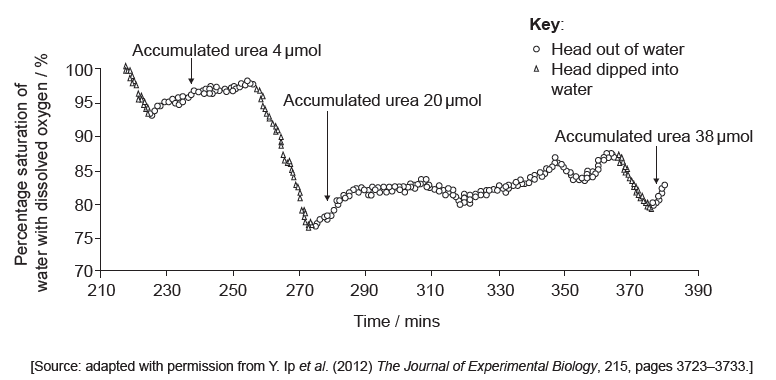
In order to test whether a urea transporter was present in the mouth tissues of the turtles, phloretin (a known inhibitor of membrane proteins that transport urea) was added to the water in which a further set of turtles submerged their heads. The results of that treatment are shown.
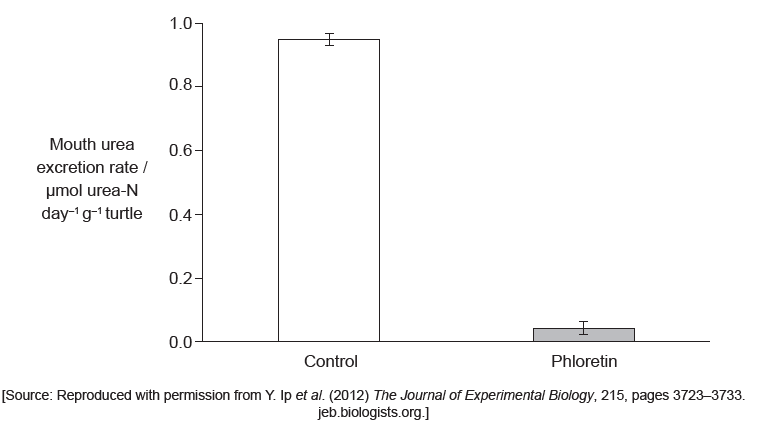
Further research was conducted to determine where mRNA expression of a urea transporter gene might be occurring in P. sinensis. Gel electrophoresis was used to analyse different tissue samples for mRNA activity.

Expression of the urea transporter gene by cells in the turtle’s mouth was assessed by measuring mRNA activity. Turtles were kept out of water for 24 hours and then injected with either a salt solution that matched the salt concentration of the turtle, dissolved ammonia or urea, followed by another 24 hours out of water.
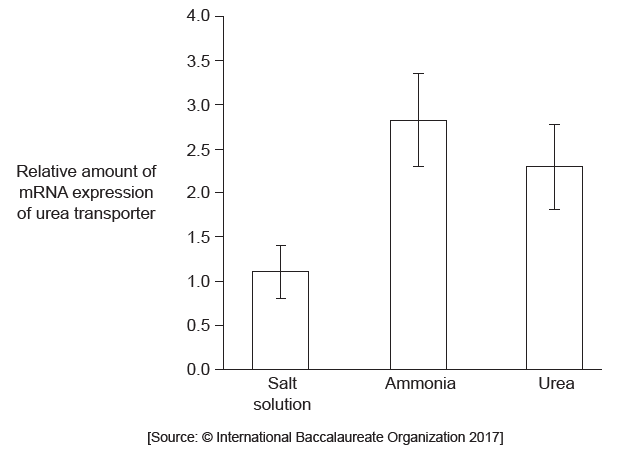
Deduce whether the excretion of ammonia or urea changes more when a turtle emerges from water.
Compare and contrast the changes in urea excretion in the mouth with the changes in urea excretion in the kidney when a turtle emerges from the water.
Describe the trends shown by the graph for dissolved oxygen in water discharged from the mouth.
Suggest reasons for these trends in dissolved oxygen.
Deduce with a reason whether a urea transporter is present in the mouth of P. sinensis.
Outline the additional evidence provided by the gel electrophoresis results shown above.
Identify which of these turtle groups represent the control, giving a reason for your answer.
Suggest a reason for the greater expression of the gene for the urea transporter after an injection with dissolved ammonia than an injection of urea.
The salt marshes where these turtles live periodically dry up to small pools. Discuss the problems that this will cause for nitrogen excretion in the turtles and how their behaviour might overcome the problems.
▶️Answer/Explanation
Markscheme
a. urea
b. for both mouth and kidney
c. percentage change/change in μmol day−1 g−1 greater with urea/other acceptable numerical comparison
a. both higher/increased on emergence from/with turtle out of water
b. both increased by 0.66 «μmol−1 g−1 when turtle emerges from water»
c. % increase is higher in kidney / kidney 940% versus mouth 73/75% / increase is higher proportionately higher in kidney / kidney x10 versus mouth nearly double/x1.73
d. urea excretion by mouth greater than kidney out of water «despite larger % increase in kidney excretion»
decrease «when head is submerged» and increase when head is out of water
a. oxygen absorbed from water/exchanged for urea when head dipped in water«so oxygen concentration decreases»
b. lungs cannot be used with head in water / can «only» be used with head out of water
c. oxygen from water «in mouth» used in «aerobic cell» respiration
d. oxygen from air dissolves in water when head out of water «so oxygen concentration increases»
a. urea transporter is present
b. less urea «excreted»/ lower rate «of urea excretion» / excretion almost zero when phloretin/inhibitor was present
a. mRNA only in mouth and tongue/in mouth and tongue but not esophagus intestine kidney or bladder
b. bands / lines indicate mRNA for/expression of urea transporter gene
c. urea transporter gene expressed / urea transporters in mouth/tongue / not expressed/made in esophagus/intestine/kidneys/bladder
d. mRNA/transcription/gene expression/urea transporters higher in tongue/more in tongue «than mouth»
salt solution is control because it does not contain a nitrogenous/excretory waste product / it matches the salt concentration of the turtle / the turtle’s body already contains salt / because the turtle lives in salt water/salt marshes / because nothing has been altered
a. ammonia is «highly» toxic/harmful
b. ammonia is more toxic than urea/converse
c. ammonia converted to urea
d. urea concentration raised «by injecting ammonia»
e. difference between ammonia and urea «possibly» not «statistically» significant
Problems:
a. urea becomes more concentrated «in small pools» / lower concentration gradient «between tongue/mouth and water»
b. less water available for urine production/excretion by kidney
OR
less water in ponds for mouth rinsing/more competition for pools (to use for mouth rinsing)
Behaviour to overcome problems:
c. «still able to» dip mouth into/mouth rinse in water/pools
d. «still able to» excrete urea «though the mouth» in the small pools
e. more conversion of ammonia to urea/urea excretion rather than ammonia
f. more urea transporters/expression of urea transporter gene
g. urea excreted «in mouth/via microvilli» by active transport/using ATP
h. excretion with little/no loss of water
Question
The diagram shows a nucleosome from the nucleus of a eukaryotic cell.
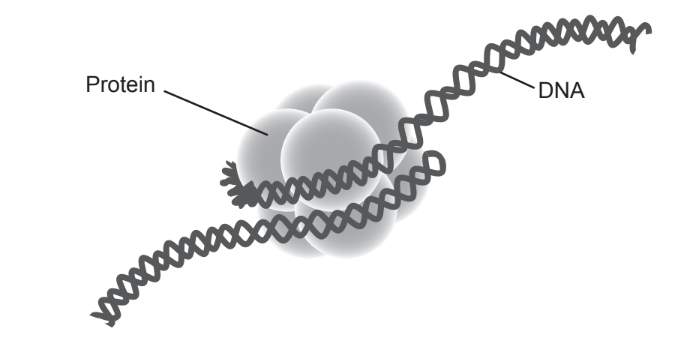
(a) Identify the protein labelled in the diagram. [1]
(b) Outline how nucleosomes affect the transcription of DNA. [1]
The image shows the regulation of the gene responsible for producing lactase.
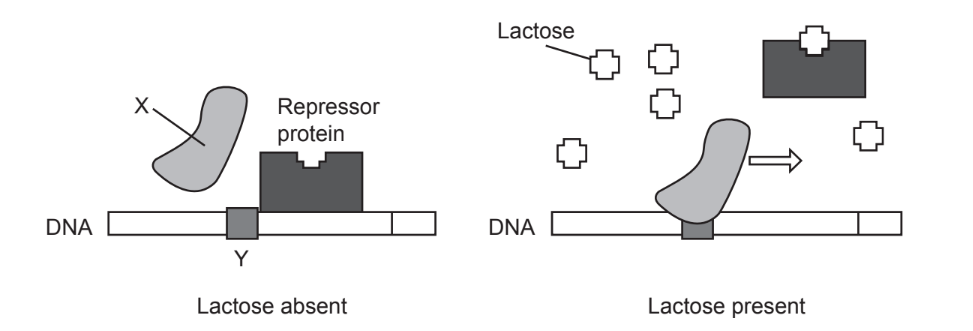
(c) Identify:
(i) X, the enzyme which copies a DNA sequence [1]
(ii) Y, non-coding DNA at the start of a gene. [1]
(d) Explain the role of lactose in the expression of the gene for lactase production. [3]
(e) State one reason that identical twins may show different methylation patterns as they grow older. [1]
▶️Answer/Explanation
a histone; 1
b a. (nucleosomes can) promote AND inhibit transcription of genes/expression of genes;
b. (nucleosomes can) prevent transcription by (tight) condensation/supercoiling/packing of DNA;
c. (nucleosomes can) allow/prevent binding of RNA polymerase/transcription factors;
d. tagging/acetylation/methylation of nucleosomes/histones can promote/inhibit transcription;
e. movement of histones/nucleosomes (along DNA) can affect which genes are transcribed;
c i RNA polymerase;
c ii promoter;
d a. lactose binds to repressor protein;
b. repressor protein (with lactose bound) cannot block/bind to the promoter/Y;
c. RNA polymerase/X binds to the promotor/transcribes the gene;
d. lactase produced (if lactose present)/lactase production inhibited if lactose absent;
e (different) environment/illness/disease/diet;
